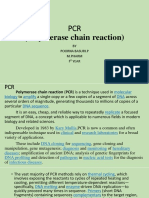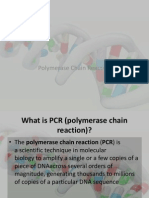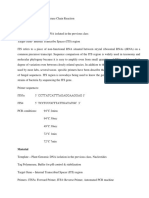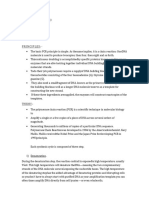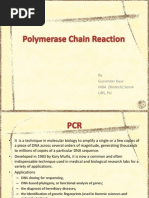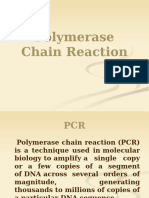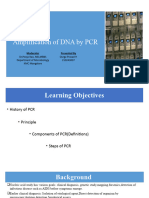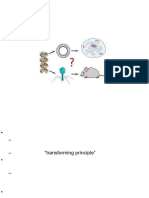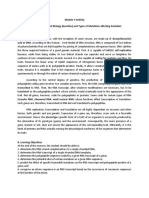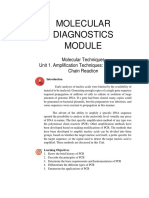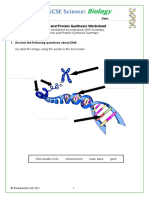0 ratings0% found this document useful (0 votes)
51 viewsDna Analysis - 1.2
Dna Analysis - 1.2
Uploaded by
Aparna PrahladPCR (polymerase chain reaction) is used to amplify or copy specific regions of DNA. It involves repeated cycles of heating and cooling DNA in the presence of primers and Taq polymerase enzyme. Each cycle doubles the amount of target DNA. By going through 25-35 cycles, PCR can generate billions of copies of the target region, allowing it to be analyzed or manipulated. The key steps are denaturation to separate DNA strands, annealing to attach primers, and extension to synthesize new strands using the primers.
Copyright:
© All Rights Reserved
Available Formats
Download as PDF, TXT or read online from Scribd
Dna Analysis - 1.2
Dna Analysis - 1.2
Uploaded by
Aparna Prahlad0 ratings0% found this document useful (0 votes)
51 views21 pagesPCR (polymerase chain reaction) is used to amplify or copy specific regions of DNA. It involves repeated cycles of heating and cooling DNA in the presence of primers and Taq polymerase enzyme. Each cycle doubles the amount of target DNA. By going through 25-35 cycles, PCR can generate billions of copies of the target region, allowing it to be analyzed or manipulated. The key steps are denaturation to separate DNA strands, annealing to attach primers, and extension to synthesize new strands using the primers.
Original Description:
Gives description about DNA amplifying technique-PCR
Original Title
Dna Analysis -1.2
Copyright
© © All Rights Reserved
Available Formats
PDF, TXT or read online from Scribd
Share this document
Did you find this document useful?
Is this content inappropriate?
PCR (polymerase chain reaction) is used to amplify or copy specific regions of DNA. It involves repeated cycles of heating and cooling DNA in the presence of primers and Taq polymerase enzyme. Each cycle doubles the amount of target DNA. By going through 25-35 cycles, PCR can generate billions of copies of the target region, allowing it to be analyzed or manipulated. The key steps are denaturation to separate DNA strands, annealing to attach primers, and extension to synthesize new strands using the primers.
Copyright:
© All Rights Reserved
Available Formats
Download as PDF, TXT or read online from Scribd
Download as pdf or txt
0 ratings0% found this document useful (0 votes)
51 views21 pagesDna Analysis - 1.2
Dna Analysis - 1.2
Uploaded by
Aparna PrahladPCR (polymerase chain reaction) is used to amplify or copy specific regions of DNA. It involves repeated cycles of heating and cooling DNA in the presence of primers and Taq polymerase enzyme. Each cycle doubles the amount of target DNA. By going through 25-35 cycles, PCR can generate billions of copies of the target region, allowing it to be analyzed or manipulated. The key steps are denaturation to separate DNA strands, annealing to attach primers, and extension to synthesize new strands using the primers.
Copyright:
© All Rights Reserved
Available Formats
Download as PDF, TXT or read online from Scribd
Download as pdf or txt
You are on page 1of 21
DNA ANALYSIS -1.
Aparna P, Ad hoc Faculty CSED,NITC
There are different techniques for analysing DNA
1. copying DNA
DNA 2.cutting & pasting DNA
ANALYSIS 3. measuring DNA
4. probing DNA
DNA Amplification/DNA copying
DNA amplification allow us to
1.DNA Studied - sequenced
manipulated – mutagenized or engineered
Copying/Ampli- expressed -generation of protein
fication Major Techniques used in DNA Amplification
1.PCR (Polymerase chain reaction)
2. Cloning
Polymerase chain reaction (PCR) is a common laboratory
technique used to make many copies (millions or billions!) of a
particular region of DNA.
1.1 PCR
It might be a gene whose function a researcher wants to
understand, or a genetic marker used by forensic scientists to match
crime scene DNA with suspects.
The goal of PCR is to make enough of the target DNA region that
it can be analyzed or used in some other way.
For instance, DNA amplified by PCR may be sent
for sequencing, visualized by gel electrophoresis, or cloned into a
Goal of PCR plasmid for further experiments.
• PCR is used in areas of biology and medicine, like molecular
biology research, medical diagnostics, and even some branches of
ecology.
Components
- PCR requires a DNA polymerase enzyme that makes new strands of
DNA, using existing strands as templates.
1. Taq
The DNA polymerase typically used in PCR is
polymerase called Taq polymerase ( from a heat-tolerant bacterium
(Thermus aquaticus) from which it was isolated)
Enzyme
Like other DNA polymerases, Taq polymerase can only make DNA
if it's given a primer, a short sequence of nucleotides that provides
2.PCR primers a starting point for DNA synthesis.
In a PCR reaction, the experimenter determines the region of DNA
that will be copied, or amplified, by the primers that they choose.
PCR primers are short pieces of single-stranded DNA, usually
around 20 nucleotides in length.
Two primers are used in each PCR reaction, and they are designed
so that they attached to the region that should be copied.
PCR i.e, they are given sequences that will make them bind to
opposite strands of the template DNA, just at the edges of the
region to be copied.
The primers bind to the template by complementary base pairing.
When the primers are bound to the template, they can be
extended by the polymerase, and the region that lies between
them will get copied.
Both primers, when bound, point “inward” – that is, in the 5’ to 3’
direction towards the region to be copied.
i.e, synthesize of DNA done only in the 5’ to 3’ direction.
Directionality
• When the primers are extended, the region that lies between
them will thus be copied.
The key ingredients of a PCR reaction are
- template DNA
- Primers
Ingredients of - Taq polymerase
- nucleotides : new DNA from the end of the primer, single units of
a PCR reaction the bases A, T, G, and C, which are essentially "building blocks" for
new DNA
• The ingredients are assembled in a tube, along with cofactors
needed by the enzyme, and are put through repeated cycles of
heating and cooling that allow DNA to be synthesized.
The basic steps are:
1.Denaturation (96°C): Heat the reaction strongly to separate, or
denature, the DNA strands.
This provides single-stranded template for the next step.
2.Annealing/Priming (55 - 65°C): Cool the reaction so the primers
Steps in PCR can bind to their complementary sequences on the single-stranded
template DNA.
3.Extension (72°C): Raise the reaction temperatures
so Taq polymerase extends the primers, synthesizing new strands of
DNA.
This cycle repeats 25 - 35 times in a typical PCR reaction,
which generally takes 2 - 4 hours, depending on the
length of the DNA region being copied.
If the reaction is efficient (works well), the target region
can go from just one or a few copies to billions.
That’s because it’s not just the original DNA that’s used as a
template each time. Instead, the new DNA that’s made in one
round can serve as a template in the next round of DNA synthesis.
There are many copies of the primers and many molecules
of Taq polymerase floating around in the reaction, so the number
of DNA molecules can roughly double in each round of cycling
You might also like
- PCR (Polymerase Chain Reaction) : Demak L. TobingDocument10 pagesPCR (Polymerase Chain Reaction) : Demak L. TobingDwitya NoviariNo ratings yet
- Ubc Issr Primer SetDocument2 pagesUbc Issr Primer SetSelvaraju Parthibhan100% (2)
- DNA Review PacketDocument6 pagesDNA Review Packeteric wyatt100% (1)
- What Is PCR?: T. Aquaticus Lives in Hot Springs and Hydrothermal Vents. Its DNA Polymerase Is Very Heat-StableDocument3 pagesWhat Is PCR?: T. Aquaticus Lives in Hot Springs and Hydrothermal Vents. Its DNA Polymerase Is Very Heat-StableFaiz RasoolNo ratings yet
- Genetics Engineering PPT Grp#09Document52 pagesGenetics Engineering PPT Grp#09Alina RajputNo ratings yet
- Polymerase chain reactionDocument8 pagesPolymerase chain reactionARUL JOENo ratings yet
- 4. PCRDocument35 pages4. PCRNive AnuNo ratings yet
- Final Pcr Lec 2022-1Document73 pagesFinal Pcr Lec 2022-1Pulok HasanNo ratings yet
- Biology PPT - Polymerase Chain ReactionDocument32 pagesBiology PPT - Polymerase Chain ReactionJay MandalNo ratings yet
- Biology PPT - Polymerase Chain ReactionDocument34 pagesBiology PPT - Polymerase Chain ReactionJay MandalNo ratings yet
- The Polymerase Chain Reaction (PCR) : General MethodsDocument11 pagesThe Polymerase Chain Reaction (PCR) : General MethodsLetícia NascimentoNo ratings yet
- pcr شرح مفصل عنDocument26 pagespcr شرح مفصل عنZainab HasanNo ratings yet
- PcrDocument13 pagesPcridhayarajendranNo ratings yet
- MiniPCR Bio Intro PCR FinalDocument2 pagesMiniPCR Bio Intro PCR FinalNicole Andree Nierra-SaleNo ratings yet
- Lab. 6 PCR Molecular Biology Dr. AmalDocument5 pagesLab. 6 PCR Molecular Biology Dr. AmalAmalNo ratings yet
- Presentation PCRDocument14 pagesPresentation PCRcyrilcastillo123No ratings yet
- PCRDocument4 pagesPCRDhinchak SowndaryaNo ratings yet
- Polymerase Chain Reaction (PCR)Document67 pagesPolymerase Chain Reaction (PCR)Derick SemNo ratings yet
- Bio Project-Polymerase Chain ReactionDocument21 pagesBio Project-Polymerase Chain ReactionS.AbiniveshNo ratings yet
- Param's PCR ProjectDocument11 pagesParam's PCR ProjectPARRU xYTNo ratings yet
- PCR - FinalDocument4 pagesPCR - FinalHanaa ElhaddadNo ratings yet
- Polymerase Chain ReactionDocument22 pagesPolymerase Chain ReactionPoornaBasuri100% (1)
- Y13 PCR & DNA ProfilingDocument16 pagesY13 PCR & DNA ProfilingFaye SweeneyNo ratings yet
- Polymerase Chain ReactionDocument19 pagesPolymerase Chain Reactionmajov83712No ratings yet
- Polymerase Chain ReactionDocument55 pagesPolymerase Chain ReactionFareeha ZahoorNo ratings yet
- Polymerase Chain Reaction BiologyDocument9 pagesPolymerase Chain Reaction Biologydynovictim10042004No ratings yet
- Polymerase Chain Reaction (PCR) : Principle of The PCRDocument5 pagesPolymerase Chain Reaction (PCR) : Principle of The PCRSalvador MartinezNo ratings yet
- Reaction Components of PCR: WaterDocument20 pagesReaction Components of PCR: Watermasabatasneem29No ratings yet
- PCRDocument1 pagePCRpqrk55dpk6No ratings yet
- Polymerase Chain ReactionDocument35 pagesPolymerase Chain ReactionVenakadalakshmi Kannappan100% (1)
- PCRDocument13 pagesPCRSnehal DabhadeNo ratings yet
- SameekshaDocument20 pagesSameekshaSameeksha DubeyNo ratings yet
- Polymerase Chain ReactionDocument36 pagesPolymerase Chain ReactionRajeswariNo ratings yet
- Polymerase Chain ReactionDocument11 pagesPolymerase Chain ReactionhasrtrfgsNo ratings yet
- PCR Amplification Lab ReportDocument5 pagesPCR Amplification Lab ReportWilson Chan100% (7)
- Experiment No. 15 Practical: Polymerase Chain ReactionDocument8 pagesExperiment No. 15 Practical: Polymerase Chain ReactionAnura BandaraNo ratings yet
- Types and ApplicationsDocument17 pagesTypes and ApplicationsMeera AKNo ratings yet
- PCR PDFDocument43 pagesPCR PDFAmirNo ratings yet
- GENETICSDocument56 pagesGENETICSKeziah Tayco100% (1)
- DNA Amplification and PCR: by Sara Haydar Mohammed Hasan Fourth Stage A2 Morning StudyDocument9 pagesDNA Amplification and PCR: by Sara Haydar Mohammed Hasan Fourth Stage A2 Morning Studydaloo dmdmNo ratings yet
- MBD SemDocument7 pagesMBD Semtranatesophie4No ratings yet
- PCR AssignmentDocument3 pagesPCR Assignmentsurbhimakwana3No ratings yet
- By Gurvinder Kaur MBA (Biotech) Sem4 Ubs, PuDocument13 pagesBy Gurvinder Kaur MBA (Biotech) Sem4 Ubs, PuJatinder Pal SinghNo ratings yet
- DNA Polymerase Primer: The PCR Reaction Requires The Following ComponentsDocument2 pagesDNA Polymerase Primer: The PCR Reaction Requires The Following ComponentsChristopher BeckerNo ratings yet
- PCRDocument21 pagesPCRpraveengamer33No ratings yet
- PCRDNA Sequencing Forensic Pedigree (1)Document35 pagesPCRDNA Sequencing Forensic Pedigree (1)sanidhaya025No ratings yet
- Polymerase Chain ReactionDocument34 pagesPolymerase Chain ReactionSruthy PBNo ratings yet
- PCR (Polymerase Chain Reaction) : DNA TemplateDocument1 pagePCR (Polymerase Chain Reaction) : DNA TemplateMARTHA CECILIA MORALES RAMOSNo ratings yet
- Concise Notes Summary Genetic Engineering PCRDocument26 pagesConcise Notes Summary Genetic Engineering PCRVoice AnonymousNo ratings yet
- Polymerase Chain ReactionDocument19 pagesPolymerase Chain ReactionKamila Haidari100% (1)
- Polymerase Chain ReactionDocument47 pagesPolymerase Chain ReactionKNo ratings yet
- PCR PresentationDocument34 pagesPCR Presentationdurgaprasadhembram1999No ratings yet
- Lec2 Nucleic Acid AmplificationDocument46 pagesLec2 Nucleic Acid AmplificationOmer BushraNo ratings yet
- Polymerase Chain ReactionDocument8 pagesPolymerase Chain ReactionAdigun TaofeeqatNo ratings yet
- Chapter 6 Nucleic Acid AmplificationDocument7 pagesChapter 6 Nucleic Acid AmplificationIsraa Al-AlemNo ratings yet
- Polymerase Chain ReactionDocument2 pagesPolymerase Chain ReactionՏᗅႮRᗅBH ՏᗅiNiNo ratings yet
- pcr basicsDocument7 pagespcr basicsElif PamukçuoğluNo ratings yet
- PCR & RDNA Technology - SJUTDocument53 pagesPCR & RDNA Technology - SJUTofficialmwalusambaNo ratings yet
- Activity 4.1.2 PCR WorksheetDocument3 pagesActivity 4.1.2 PCR Worksheet3021031No ratings yet
- Next Generation Sequencing and Sequence Assembly: Methodologies and AlgorithmsFrom EverandNext Generation Sequencing and Sequence Assembly: Methodologies and AlgorithmsNo ratings yet
- Nukleus Dan NukleolusDocument63 pagesNukleus Dan NukleolusKarin NakajimaNo ratings yet
- 9700 - s17 - 21 - Q3ab and w19 - 21 - Q1 and w19 - 22 - Q3ciDocument6 pages9700 - s17 - 21 - Q3ab and w19 - 21 - Q1 and w19 - 22 - Q3cisrividhyaNo ratings yet
- Molecular Basis of Inheritance - Super Notes by Seep PahujaDocument75 pagesMolecular Basis of Inheritance - Super Notes by Seep Pahujaaltashabts7100% (3)
- Oligo ExtraDocument2 pagesOligo ExtraGabriela Zaldivar MendozaNo ratings yet
- 64212-08 RNA SplicingDocument41 pages64212-08 RNA SplicingKhadija MohammedNo ratings yet
- Lecture 6. Epigenetics.Document26 pagesLecture 6. Epigenetics.Shariful HemelNo ratings yet
- RNA and Protein Synthesis Problem SetDocument6 pagesRNA and Protein Synthesis Problem Setpalms thatshatterNo ratings yet
- Transpososome Dynamics and RegulationDocument18 pagesTranspososome Dynamics and RegulationHaru SahaNo ratings yet
- Transposons in HumansDocument22 pagesTransposons in HumansRishiNo ratings yet
- Chapter On TranscriptomicsDocument13 pagesChapter On TranscriptomicsMazhar FarNo ratings yet
- Midterm Exam For BIOLOGY RogersDocument2 pagesMidterm Exam For BIOLOGY RogersGarde PiaoNo ratings yet
- Animal TransformationDocument29 pagesAnimal TransformationRejayne JuyadNo ratings yet
- Module 3 Activity Central DogmaDocument5 pagesModule 3 Activity Central DogmaNORODIN DALANDAS0% (1)
- Answerkey ExamI 13Document10 pagesAnswerkey ExamI 13waldo625No ratings yet
- Biology Stop TestDocument35 pagesBiology Stop TestTemmuz AkyolNo ratings yet
- Protein Synthesis WorksheetDocument2 pagesProtein Synthesis WorksheetJuan Esteban Escandon AgudeloNo ratings yet
- Biology 1st Paper All MCQDocument23 pagesBiology 1st Paper All MCQrafikrafikxcvNo ratings yet
- Gene Expression: 1: Activation (Overview), Transcription, TranslationDocument38 pagesGene Expression: 1: Activation (Overview), Transcription, TranslationEdward WinchesterrNo ratings yet
- Molecular and Mendelian Genetics - 202203202253Document7 pagesMolecular and Mendelian Genetics - 202203202253Ej AgsaldaNo ratings yet
- BIO213-Introduction To Quantitative BiologyDocument14 pagesBIO213-Introduction To Quantitative BiologyMansi SharmaNo ratings yet
- Unit 1 Amplification TechniqueDocument9 pagesUnit 1 Amplification TechniqueShin BoyceNo ratings yet
- Genetoprotein FogliaDocument45 pagesGenetoprotein Fogliaapi-277471896100% (1)
- Advance Bacterial GeneticsDocument5 pagesAdvance Bacterial GeneticsEvi RoviatiNo ratings yet
- Pet 15 BMDocument2 pagesPet 15 BMNick FisherNo ratings yet
- DNA and Protein Synthesis WorksheetDocument5 pagesDNA and Protein Synthesis Worksheeteula faith miracle andam100% (2)
- Regulation of Gene ExpressionDocument34 pagesRegulation of Gene ExpressionJay Fickle100% (1)
- Cell Biology) 9. DNA Transcription - KeyDocument1 pageCell Biology) 9. DNA Transcription - Keysaranya sankarNo ratings yet
- Gene FindingDocument31 pagesGene FindingAnmol MalikNo ratings yet





















